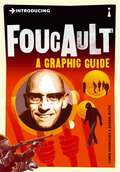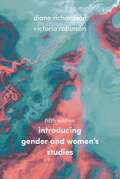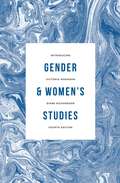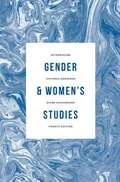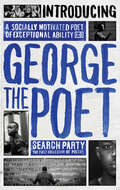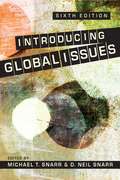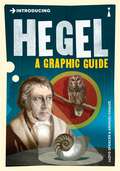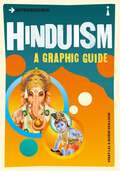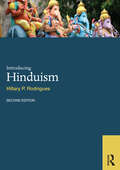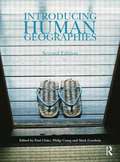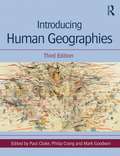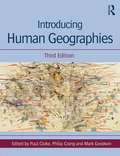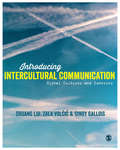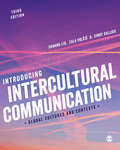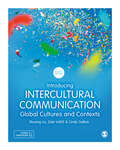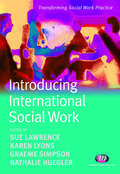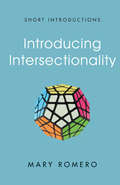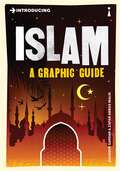- Table View
- List View
Introducing Foucault: A Graphic Guide (Introducing...)
by Chris HorrocksMichel Foucault's work was described at his death as 'the most important event of thought in our century'. As a philosopher, historian and political activist, he certainly left behind an enduring and influential body of work, but is this acclaim justified? "Introducing Foucault" places his work in its turbulent philosophical and political context, and critically explores his mission to expose the links between knowledge and power in the human sciences, their discourses and institutions. This book explains how Foucault overturned our assumptions about the experience and perception of madness, sexuality and criminality, and the often brutal social practices of confinement, confession and discipline. It also describes Foucault's engagement with psychiatry and clinical medicine, his political activism and the transgressive aspects of pleasure and desire that he promoted in his writing.
Introducing Gender and Women's Studies
by Diane Richardson and Victoria RobinsonAt a time where, after decades of progress in gender and sexual rights, people in many parts of the world are facing new forms of resistance and opposition to gender equality, this timely publication confirms the continuing importance and relevance of gender and women's studies.The fifth edition of this best-selling textbook provides a comprehensive overview of key issues and debates in gender and feminist theory. With fully revised chapters written by specialists across a range of core topics including sexuality, race, bodies, family, masculinity, methodologies and migration, this clearly written but rigorous collection examines contemporary debates and provides helpful examples and questions to consider.Furthermore, it continues to reflect the shift from women's studies to gender studies, incorporating coverage of masculinity throughout, as well as discussing live debates such as around global activism, transgender rights and the environment. It continues to be an indispensable resource for students, academics and anyone interested in this lively field.New to this Edition:- A new chapter on gender and migration- Expanded discussion of transgender rights as well as masculinity studies- Brings seven new contributors to the collection; with newly authored chapters on Gender and Environment, Gender and Education, Gender and Sexuality and Gender and Race- Fully revised and updated with new material and new case examples- Greater attention to intersectional approaches and international reach
Introducing Gender and Women's Studies
by Liz Kelly Gayle Letherby Kath Woodward Priscilla Dunk-West Debbie Epstein Ruth Holliday Stevi Jackson Kate Reed Sally Hines Heather Brook Nickie Charles Jessica Ringrose Zoe Irving Padini Nirmal Diane RocheleauThe fourth edition of this classic, comprehensive and best-selling text on gender and women's studies marks over twenty years of engaging with the key issues and developments in gender and feminist theory. With fully revised chapters written by specialists across a range of core topics, including sexuality, work, the media, race, education, family, bodies, masculinity, methodologies, social movements and politics, this accessible but academically rigorous collection breaks down contemporary debates with helpful examples and questions, whilst also underlining the complexities and contradictions of this area of study. In particular, this new edition: • continues to reflect the shift from 'women's studies' to 'gender studies', incorporating masculinity studies throughout;• features new chapters on violence and the environment, reflecting continuing and more recent feminist concerns; • includes expanded discussion of intersectionality, international and transnational issues. Coinciding with an upsurge in new forms of feminist politics, this timely publication confirms the continuing relevance of gender and women's studies. It remains an indispensable resource for students, academics and anyone interested in this lively field.
Introducing Gender And Women's Studies (PDF)
by Victoria Robinson Diane RichardsonThe fourth edition of this classic, comprehensive and best-selling text on gender and women's studies marks over twenty years of engaging with the key issues and developments in gender and feminist theory. With fully revised chapters written by specialists across a range of core topics, including sexuality, work, the media, race, education, family, bodies, masculinity, methodologies, social movements and politics, this accessible but academically rigorous collection breaks down contemporary debates with helpful examples and questions, whilst also underlining the complexities and contradictions of this area of study. In particular, this new edition: * continues to reflect the shift from 'women's studies' to 'gender studies', incorporating masculinity studies throughout; * features new chapters on violence and the environment, reflecting continuing and more recent feminist concerns; * includes expanded discussion of intersectionality, international and transnational issues. Coinciding with an upsurge in new forms of feminist politics, this timely publication confirms the continuing relevance of gender and women's studies. It remains an indispensable resource for students, academics and anyone interested in this lively field.
Introducing George The Poet: Search Party: A Collection of Poems
by George The Poet‘The title is Search Party – the idea being that we’re all out here looking for something, and my poems are my way of finding myself.’ A young black poet blending spoken word and rap; an inner city upbringing with a Cambridge education; a social consciousness with a satirical wit and infectious rhythm – George The Poet is the voice of a new generation.Search Party is a thought-provoking and deeply autobiographical collection. From the overtly political ‘Go Home’ to the deeply personal ‘Full-time’; the narrative poems that offer vivid and unapologetic snapshots of inner-city life, such as ‘His Mistakes’, ‘Believer’ and the anthemic ‘My City’; to the provocative social commentary in ‘Lazy Dog’ and ‘YOLO’; to the inspiring, idea-driven pieces such as ‘The Power of Collaboration’ and ‘School Blues’, George takes poetry into new territories and to new audiences, offering a different way to talk about the things that matter, to explore his own experience and ideas, and encourage others explore theirs.George The Poet’s mesmerising and unforgettable live performances have earned him critical acclaim. From sell-out headline gigs and YouTube hits, to recording his own music, and now his first collection of poetry, George uses his work to speak truth to power and challenge our preconceived ideas about the society we’re living in.Whether you’re searching for yourself, for answers, for change – join the search party.
Introducing Global Issues (6th Edition) (PDF)
by Michael Snarr D. SnarrHow is new technology - cyberwarfare, drones, and more - affecting global security? Are the 2015 Sustainable Development Goals having an impact What progress are governments making in dealing with climate change? Is there a viable solution to the Syrian refugee crisis? How do we reconcile the concepts of universal human rights and national sovereignty? These are among the difficult questions addressed in this new, fully revised and updated edition of Introducing Global Issues. The material has been successfully designed for readers with little or no prior knowledge of the topics covered. Each chapter provides an analytical overview of the issue addressed, identifies central actors and perspectives, and outlines past progress and future prospects. Discussion questions are posed to enhance students' appreciation of the complexities involved, and suggestions for further reading additionally enrich the text.
Introducing Hegel: A Graphic Guide (Introducing...)
by Lloyd SpencerINTRODUCING guide to the hugely influential German thinker. Georg Wilhelm Friedrich Hegel is one of the greatest thinkers of all time. No other philosopher has had such a profound impact on the ideas and political events of the 20th century. Hegel's influential writings on philosophy, politics, history and art are parts of a larger systematic whole. They are also among the most difficult in the entire literature of philosophy. Introducing Hegel guides us through a spectacular system of thought which aimed to make sense of history. The book also provides new perspectives on contemporary postmodern debates about 'metanarratives' (Lyotard) and the 'end of history' (Fukuyama). It is an ideal introduction to this crucial figure in the history of philosophy, and is indispensable for anyone trying to understand such key modern thinkers as Marx, Lacan, Satre and Adorno.
Introducing Hinduism: A Graphic Guide (Introducing... Ser.)
by Vinay Lal Borin Van LoonWhy do Hindus revere the cow? Must Hindus be vegetarian? Introducing Hinduism offers a guide to the key philosophical, literary, mythological and cultural traditions of the extraordinarily diverse faith. It untangles the complexities of Hinduism's gods and goddesses, its caste system and its views on sex, everyday life and asceticism.
Introducing Hinduism (World Religions)
by Hillary P. RodriguesIntroducing Hinduism, 2nd Edition is the ideal sourcebook for those seeking a comprehensive overview of the Hindu tradition. This second edition includes substantial treatments of Tantra, South India, and women, as well as expanded discussions of yoga, Vedanta and contemporary configurations of Hinduism in the West. Its lively presentation features: case studies, photographs, and scenarios that invite the reader into the lived world of Hinduism; introductory summaries, key points, discussion questions, and recommended reading lists at the end of each chapter; narrative summaries of the great epics and other renowned Hindu myths and lucid explanations of complex Indian philosophical teachings, including Sankhya and Kashmir Saivism; and a glossary, timeline, and pronunciation guide for an enhanced learning experience. This volume is an invaluable resource for students in need of an introduction to the key tenets and diverse practice of Hinduism, past and present.
Introducing Hinduism (World Religions)
by Hillary P. RodriguesIntroducing Hinduism, 2nd Edition is the ideal sourcebook for those seeking a comprehensive overview of the Hindu tradition. This second edition includes substantial treatments of Tantra, South India, and women, as well as expanded discussions of yoga, Vedanta and contemporary configurations of Hinduism in the West. Its lively presentation features: case studies, photographs, and scenarios that invite the reader into the lived world of Hinduism; introductory summaries, key points, discussion questions, and recommended reading lists at the end of each chapter; narrative summaries of the great epics and other renowned Hindu myths and lucid explanations of complex Indian philosophical teachings, including Sankhya and Kashmir Saivism; and a glossary, timeline, and pronunciation guide for an enhanced learning experience. This volume is an invaluable resource for students in need of an introduction to the key tenets and diverse practice of Hinduism, past and present.
Introducing Human Geographies
by Paul Cloke Philip Crang Mark GoodwinIntroducing Human Geographies is a comprehensive, stimulating and innovative introduction to human geography. This second edition has been thoroughly revised and updated to build upon the success of the acclaimed first edition. Now in full color and with sixteen new chapters, discussion points and glossary definitions in the margin, it is even more accessible.
Introducing Human Geographies, Third Edition
by Paul Cloke Philip Crang Mark GoodwinIntroducing Human Geographiesis the leading guide to human geography for undergraduate students, explaining new thinking on essential topics and discussing exciting developments in the field. This new edition has been thoroughly revised and updated and coverage is extended with new sections devoted to biogeographies, cartographies, mobilities, non-representational geographies, population geographies, public geographies and securities. Presented in three parts with 60 contributions written by expert international researchers, this text addresses the central ideas through which human geographers understand and shape their subject. Part I: Foundations engages students with key ideas that define human geography's subject matter and approaches, through critical analyses of dualisms such as local-global, society-space and human-nonhuman. Part II: Themes explores human geography's main sub-disciplines, with sections devoted to biogeographies, cartographies, cultural geographies, development geographies, economic geographies, environmental geographies, historical geographies, political geographies, population geographies, social geographies, urban and rural geographies. Finally, Part III: Horizons assesses the latest research in innovative areas, from mobilities and securities to non-representational geographies. This comprehensive, stimulating and cutting edge introduction to the field is richly illustrated throughout with full colour figures, maps and photos. These are available to download on the companion website, located at www. routledge. com/9781444135350.
Introducing Human Geographies, Third Edition
by Paul Cloke Philip Crang Mark GoodwinIntroducing Human Geographies is the leading guide to human geography for undergraduate students, explaining new thinking on essential topics and discussing exciting developments in the field. This new edition has been thoroughly revised and updated and coverage is extended with new sections devoted to biogeographies, cartographies, mobilities, non-representational geographies, population geographies, public geographies and securities. Presented in three parts with 60 contributions written by expert international researchers, this text addresses the central ideas through which human geographers understand and shape their subject. Part I: Foundations engages students with key ideas that define human geography’s subject matter and approaches, through critical analyses of dualisms such as local-global, society-space and human-nonhuman. Part II: Themes explores human geography’s main sub-disciplines, with sections devoted to biogeographies, cartographies, cultural geographies, development geographies, economic geographies, environmental geographies, historical geographies, political geographies, population geographies, social geographies, urban and rural geographies. Finally, Part III: Horizons assesses the latest research in innovative areas, from mobilities and securities to non-representational geographies. This comprehensive, stimulating and cutting edge introduction to the field is richly illustrated throughout with full colour figures, maps and photos. These are available to download on the companion website, located at www.routledge.com/9781444135350.
Introducing Human Geographies, Third Edition
by Paul Cloke Philip Crang Mark GoodwinIntroducing Human Geographies is the leading guide to human geography for undergraduate students, explaining new thinking on essential topics and discussing exciting developments in the field. This new edition has been thoroughly revised and updated and coverage is extended with new sections devoted to biogeographies, cartographies, mobilities, non-representational geographies, population geographies, public geographies and securities. Presented in three parts with 60 contributions written by expert international researchers, this text addresses the central ideas through which human geographers understand and shape their subject. Part I: Foundations engages students with key ideas that define human geography’s subject matter and approaches, through critical analyses of dualisms such as local-global, society-space and human-nonhuman. Part II: Themes explores human geography’s main sub-disciplines, with sections devoted to biogeographies, cartographies, cultural geographies, development geographies, economic geographies, environmental geographies, historical geographies, political geographies, population geographies, social geographies, urban and rural geographies. Finally, Part III: Horizons assesses the latest research in innovative areas, from mobilities and securities to non-representational geographies. This comprehensive, stimulating and cutting edge introduction to the field is richly illustrated throughout with full colour figures, maps and photos. These are available to download on the companion website, located at www.routledge.com/9781444135350.
Introducing Intercultural Communication: Global Cultures and Contexts
by Cindy Gallois Dr Shuang Liu Zala VolcicIntroducing Intercultural Communication uses examples and case studies from around the world to situate communication theory in a truly global perspective. Covering the essentials from international conflict to migration and social networking, this book shows students how to master the skills and concepts at work in how we communicate and understand each other across cultural boundaries. Each chapter brings to life the links between theory and practice, and between the global and local, showing you how to understand the influence of your culture on how you view yourself and others. In this book: Theory boxes show you how to use key ideas in work contexts. Case studies from European, Chinese, Australian and American contexts give you a truly global perspective. Critical questions help you to challenge yourself. A full chapter gives practical tips on how to become an effective intercultural communicator. Annotated lists of further reading and free access to online SAGE journal articles assist you in your research. A companion website (https://study.sagepub.com/liu2e) provides you with exercise questions, as well as extended reading lists. This book will guide you to success in your studies and will teach you to become a more critical consumer of information.
Introducing Intercultural Communication: Global Cultures and Contexts
by Cindy Gallois Dr Shuang Liu Zala VolcicIntroducing Intercultural Communication uses examples and case studies from around the world to situate communication theory in a truly global perspective. Covering the essentials from international conflict to migration and social networking, this book shows students how to master the skills and concepts at work in how we communicate and understand each other across cultural boundaries. Each chapter brings to life the links between theory and practice, and between the global and local, showing you how to understand the influence of your culture on how you view yourself and others. In this book: Theory boxes show you how to use key ideas in work contexts. Case studies from European, Chinese, Australian and American contexts give you a truly global perspective. Critical questions help you to challenge yourself. A full chapter gives practical tips on how to become an effective intercultural communicator. Annotated lists of further reading and free access to online SAGE journal articles assist you in your research. A companion website (https://study.sagepub.com/liu2e) provides you with exercise questions, as well as extended reading lists. This book will guide you to success in your studies and will teach you to become a more critical consumer of information.
Introducing Intercultural Communication: Global Cultures and Contexts
by Dr Shuang Liu Zala Volcic Cindy GalloisTaking a truly global perspective, this textbook presents concepts, theories and applications from the field of intercultural communication in a lively and easy-to-follow style. Covering all the essential topics, from immigration to intercultural conflict to the impact of mass media and technology, this cutting edge new edition features: A student-friendly structure with enhanced signposting to guide students through the book. Expanded coverage of ethics, digital communication and social media. A brand new set of international case studies to tie theory to real-world practices, including the European refugee crisis, Chinese food culture and Barbie dolls and beauty. A suite of student-friendly learning features, including ‘Do it!’ activity boxes, chapter summaries and applications of key theories in ‘Theory Corner’. Links to further reading and SAGE Video to help understanding. A host of online resources to reinforce students' learning, including multiple choice quizzes, discussion questions and exercises. Introducing Intercultural Communication is the ideal guide to becoming a critical consumer of information and an effective global citizen. It should be required reading for students in media and communications, business and management, linguistics and beyond.
Introducing Intercultural Communication: Global Cultures and Contexts
by Dr Shuang Liu Zala Volcic Cindy GalloisTaking a truly global perspective, this textbook presents concepts, theories and applications from the field of intercultural communication in a lively and easy-to-follow style. Covering all the essential topics, from immigration to intercultural conflict to the impact of mass media and technology, this cutting edge new edition features: A student-friendly structure with enhanced signposting to guide students through the book. Expanded coverage of ethics, digital communication and social media. A brand new set of international case studies to tie theory to real-world practices, including the European refugee crisis, Chinese food culture and Barbie dolls and beauty. A suite of student-friendly learning features, including ‘Do it!’ activity boxes, chapter summaries and applications of key theories in ‘Theory Corner’. Links to further reading and SAGE Video to help understanding. A host of online resources to reinforce students' learning, including multiple choice quizzes, discussion questions and exercises. Introducing Intercultural Communication is the ideal guide to becoming a critical consumer of information and an effective global citizen. It should be required reading for students in media and communications, business and management, linguistics and beyond.
Introducing Intercultural Communication: Global Cultures and Contexts
by Shuang Liu Zala Volcic Cindy GalloisTaking a global and critical perspective, this textbook presents the concepts, theories and applications from the field of intercultural communication in a lively and easy-to-follow style. Covering all the essential topics, from immigration and intercultural conflict, to intercultural health communication and communication in the workplace, this cutting-edge 4th edition: Explains the key theories and concepts you need to know. Brings theory to life with a range of global case studies. Ties key ideas and debates to the reality of intercultural skills and practice. Adds a new chapter on intercultural communication and business. Expands coverage of topical areas such as health and crisis communication and virtual communication in the workplace. Introducing Intercultural Communication is the ideal guide to becoming a critical consumer of information and an effective global citizen. It is essential reading for students of intercultural communication across media and communication studies, and international business and management.
Introducing Intercultural Communication: Global Cultures and Contexts
by Shuang Liu Zala Volcic Cindy GalloisTaking a global and critical perspective, this textbook presents the concepts, theories and applications from the field of intercultural communication in a lively and easy-to-follow style. Covering all the essential topics, from immigration and intercultural conflict, to intercultural health communication and communication in the workplace, this cutting-edge 4th edition: Explains the key theories and concepts you need to know. Brings theory to life with a range of global case studies. Ties key ideas and debates to the reality of intercultural skills and practice. Adds a new chapter on intercultural communication and business. Expands coverage of topical areas such as health and crisis communication and virtual communication in the workplace. Introducing Intercultural Communication is the ideal guide to becoming a critical consumer of information and an effective global citizen. It is essential reading for students of intercultural communication across media and communication studies, and international business and management.
Introducing Intercultural Communication: Global Cultures and Contexts
by Shuang Liu Zala Volcic Cindy GalloisTaking a global and critical perspective, this textbook presents the concepts, theories and applications from the field of intercultural communication in a lively and easy-to-follow style. Covering all the essential topics, from immigration and intercultural conflict, to intercultural health communication and communication in the workplace, this cutting-edge 4th edition: Explains the key theories and concepts you need to know. Brings theory to life with a range of global case studies. Ties key ideas and debates to the reality of intercultural skills and practice. Adds a new chapter on intercultural communication and business. Expands coverage of topical areas such as health and crisis communication and virtual communication in the workplace. Introducing Intercultural Communication is the ideal guide to becoming a critical consumer of information and an effective global citizen. It is essential reading for students of intercultural communication across media and communication studies, and international business and management.
Introducing International Social Work
by Sue Lawrence Karen H. Lyons Mr Graeme Simpson Ms Nathalie HueglerThis book guides the reader through the international development of social work and discusses how aspects of globalisation are making it an increasingly international activity and profession. Individual chapters locate the UK population historically and currently as a multicultural community and explore the international issues that social workers in the UK confront in their daily practice with children and families, people with mental health issues and older people. This text helps students meet the academic benchmarks and National Occupational Standards that require them to locate social work practice in a European and international context.
Introducing International Social Work
by Karen H. Lyons Mr Graeme Simpson Ms Nathalie Huegler Sue LawrenceThis book guides the reader through the international development of social work and discusses how aspects of globalisation are making it an increasingly international activity and profession. Individual chapters locate the UK population historically and currently as a multicultural community and explore the international issues that social workers in the UK confront in their daily practice with children and families, people with mental health issues and older people. This text helps students meet the academic benchmarks and National Occupational Standards that require them to locate social work practice in a European and international context.
Introducing Intersectionality (Short Introductions)
by Mary RomeroHow can we hope to understand social inequality without considering race, class, and gender in tandem? How do they interact with other categories such as sexuality, citizenship, and ableism? How does an inclusive analysis of domination and privilege move us closer to solutions touching the lives of diverse populations? In this clearly written book, Mary Romero presents intersectionality as a core facet of the sociological imagination. One-dimensional approaches are no longer acceptable. Instead, we must examine all systems of oppression simultaneously and how they integrate and work with or against each other to shape life experiences. Recognizing the dynamics of patriarchy, capitalism, and white supremacy, Romero shows how social inequality is maintained or minimized in various social settings and everyday sites of interaction. Drawing the theoretical threads together, the book demonstrates intersectional approaches in action in relation to the care crisis and wealth divide, to highlight the different understandings of these issues and their solutions arising from a comprehensive, intersectional examination. Offering an overview of scholarly and activist tradition in the development of intersectionality and how to apply intersectionality as a lens to enrich our understandings of social life, this introductory text will be an invaluable and welcome resource for all students of sociology.
Introducing Islam: A Graphic Guide (Introducing...)
by Ziauddin SardarIslam is one of the world's great monotheistic religions. Islamic culture, spanning 1,500 years, has produced some of the finest achievements of humanity. Yet the religion followed by a fifth of humankind is too often seen in the West in terms of fundamentalism, bigotry and violence- a perception that couldn't be more wrong. Introducing Islam recounts the history of Islam from the birth of Prophet Muhammad in the 6th century to its status as a global culture and political force today. Charting the achievements of Muslim civilisation, it explains the nature and message of the Qur'an, outlines the basic features of Islamic law, and assesses the impact of colonialism on Muslim societies. Ziauddin Sardar and Zafar Abbas Malik show how Muslims everywhere are trying to live their faith and are shaping new Islamic ideas and ideals for a globalised world.
